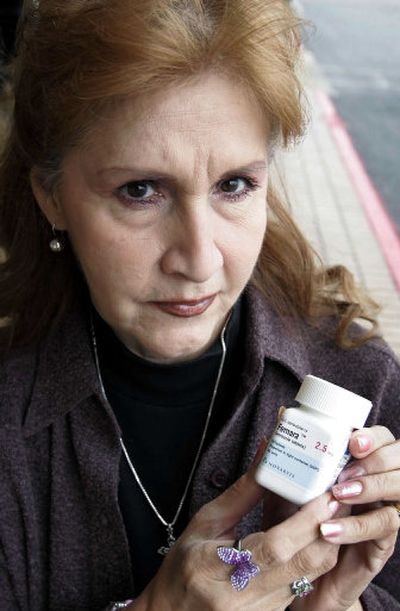New guidelines mean less chemo

SAN ANTONIO – For years, doctors have known exactly what to do with breast cancer patients like Eva Ossorio: Poison them.
Blasting women with toxic chemicals was considered the best way to save their lives. The bigger the cancer or the more it had spread, the more vile liquid doctors pumped into their veins to try to kill it.
But there’s been a sea change in the last year.
Guidelines recently adopted in Europe and similar ones unveiled this weekend at a conference in Texas will result in far fewer women getting chemotherapy in the future.
The new advice calls for choosing a treatment based on each woman’s particular type of tumor.
“In the past, we made all decisions based on how big the tumor was and whether the lymph nodes were involved. If you had a lot of cancer, you got treated one way, and if you had a little cancer, you got treated another way,” said Dr. Eric Winer of the Dana-Farber Cancer Center in Boston.
Under the new rules, hormone status – whether a tumor’s growth depends on estrogen or progesterone – becomes the single most important factor in picking treatment.
That is why Ossorio, a 62-year-old nurse in San Antonio, last week was started on a hormone blocker rather than the chemo she formerly would have been given for her relatively large tumor. She was relieved.
“I don’t care if I die tomorrow. I decided I didn’t want chemotherapy,” she said.
Women have reason to dread it. Chemo is a sledgehammer, killing all rapidly dividing cells whether they are out-of-control cancerous ones or healthy ones that naturally grow quickly, like those lining the mouth and stomach. That’s why chemo causes hair loss, nausea and mouth sores.
But the worst part is, it only helps about 15 percent of those who get it after the usual surgery to remove their tumors. Roughly 25 percent get worse despite chemo. A whopping 60 percent would have been fine with hormone treatments alone.
“For the vast majority of patients, we probably overtreat,” said Dr. William Gradishar of Northwestern University in Chicago.
“It’s not that chemotherapy is not of value, it’s that the value is smaller in women with hormone-driven disease,” said Dr. Robert Carlson, a Stanford University physician who led the U.S. guideline-writing group. “We’re trying to determine if the benefit is so small that we should not be recommending chemotherapy.”
Several developments in recent years help doctors pick who really needs it.
First is the realization that breast cancers have different causes, arise from different types of cells, are driven by different genes, and tend to be different in women before or after menopause.
“Breast cancer must be understood as an umbrella of diseases,” said Dr. Antonio Wolff of Johns Hopkins Medical Institute in Baltimore.
For example, three-fourths of postmenopausal women have tumors fueled by estrogen, called ER-positive disease. Drugs that block this hormone, like tamoxifen and a newer class of medications called aromatase inhibitors, work against those cancers – whether they have spread to lymph nodes or not.
On the other hand, women before menopause often have tumors that are ER-negative and orchestrated by bad genes. Hormones don’t help in that case; these women benefit most from chemotherapy.
If hormone drugs are ball-peen hammers compared to chemotherapy, a medication like Herceptin is an even more refined tool. It targets the one-fourth of breast cancers that have too much of a protein on cell surfaces called HER-2 and leaves healthy cells alone.
A woman’s HER-2 status is the next factor doctors will consider, after hormone status, in choosing treatments under the new guidelines.
You can see the possibilities: half of HER-2 tumors are ER-positive, but only 10 percent of ER-positive tumors are HER-2-negative.
These aren’t black-and-white distinctions, either. Tumors can be weakly ER-positive or negative; same thing for HER-2.
New high-tech lab tests help doctors sort it out. They measure the activity of dozens of genes and reveal which ones are most active and what treatments would work best.
One such test, Oncotype DX, has found its way into more and more doctors’ offices since presentations at the Texas cancer meeting last year showed its ability to predict which women benefit from tamoxifen and which do best on chemo.
Ossorio’s doctor ordered the test because she thought it would convince Ossorio to have chemo. Surprisingly, it revealed chemo was very unlikely to help.
The test is expensive – $3,400 – but many insurers cover it because it often prevents even more costly and unnecessary chemo, as it did for Ossorio.
Dr. Larry Norton, breast cancer chief at Memorial Sloan-Kettering Cancer Center in New York, uses it when situations are complex and treatment choices aren’t obvious. He compares it to lab tests that pinpoint a germ so the right antibiotic can be prescribed.
“In the old days, people just said ‘Pneumonia.’ Now we say ‘What organism?’ and that lets us identify how to treat the disease,” he said.
But relying on factors like hormone and HER-2 status makes the accuracy of lab tests a life-or-death matter. Doctors warn about the wide variation in the quality of such tests, whether low- or high-tech.
“The right (test) is the one that is done right,” not which type of test is chosen, Wolff told doctors at the Texas meeting who had come to learn about the U.S. guidelines. The new guidance was developed by the National Comprehensive Cancer Network, a group of leading cancer treatment centers, in cooperation with the American Cancer Society.
They soon will be published and are available now on the network’s Web site, www.nccn.org.